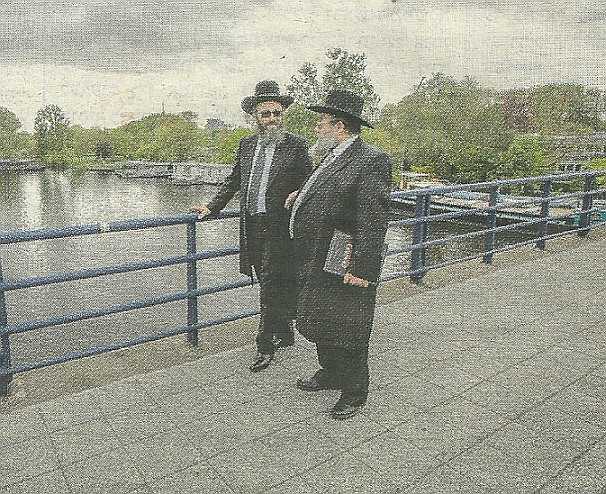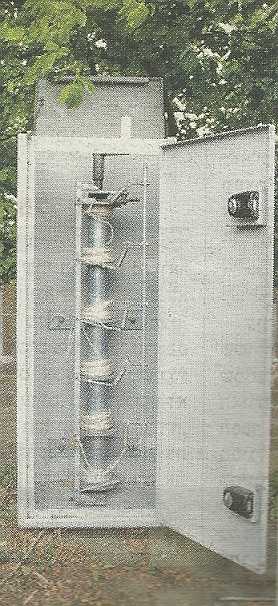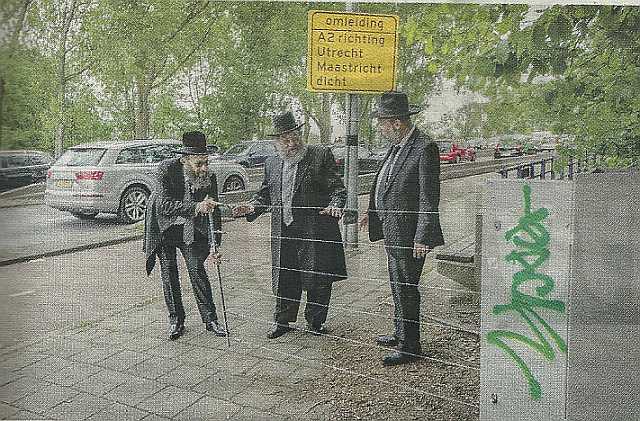 The outgoing rabbi of Amsterdam Rabbi Ralbag (R) and the incoming rabbi of Amsterday Rabbi Wolf (L) walking on one of Amsterdam's many bridges.
The outgoing rabbi of Amsterdam Rabbi Ralbag (R) and the incoming rabbi of Amsterday Rabbi Wolf (L) walking on one of Amsterdam's many bridges.
At the conclusion of this assembly, the rabbonim-dayonim left the hall to inspect the new eruv which was established for this city of canals. From the heights of the bridge, the waters seemed calm, not hinting at the stormy sessions in the beis medrash over this intricate subject.
"Up till 1972, the city eruv was based on the heter of "doors that can be locked," a situation that existed for many years before the World War. At that time, there was am halachic door which was fashioned from the lovud concept of joining the empty spaces between iron chains. Many of Amsterdam's Jews relied on this and carried on Shabbos."
Where does the eruv pass? It encompasses on the northern side of the neighborhood where the Amstel River flows, and from the east the ports of large ships. We stood on the bridge which spans the Amstel River in the eastern side of the city, feeling a pleasant breeze blowing towards evening. The Schinkal, a network of man-made channels, is located on the western side of Amsterdam.
One of the boxes holding coiled chains used in the Amsterdam eruv

HaRav Arye Ralbag notes that in the past, there were drawbridges which lifted up. HaRav Yaakov Sasportes wrote a response quoted in Pischei Teshuva that "walls of water" meaning the sides of the river bank and the canals were considered the main mechitza-partition. However the bridges nullified that water partition. Since many people passed to and fro, it couldn't be considered a real partition. When the drawbridge was raised up, the partition returned. Halachically it was comparable to a door opening and closing, a "door which can be locked," making this a legitimate mechitza all the time.
HaRav Eliezer Wolf: "With time, permanent bridges were built that could not be raised. The new solution found in Amsterdam was to erect a door of sorts through chains coiled up in a chest (see photographs), creating a halachically proper door through the principle of lovud. The chains could be extended, barring the bridge to pedestrians so that the water partitions could be again considered proper partitions. There were some halachic experts, such as the Avnei Nezer and the Admor of Radzin who challenged this, but in Amsterdam, the chain gates continued to be in valid use as the eruv until HaRav Meir Just zt"l stopped this. In addition, technical discrepancies cropped up since the rolled up chains got entangled and could not be extended and remained lying down.
When HaRav Arye Ralbag presided as dayan of Amsterdam, he found that many Jews were carrying on Shabbos without any eruv. "I wrote an essay presenting a possible solution for Amsterdam and its particular situation and sent it to several halachic authorities," he told us. In time, their responsa came back: that of the Shevet HaLevi; HaRav R' Yisroel Yaakov Fisher; the Av Beis Din of London HaRav Chanoch Dov Padua; the Av Beis Din of Strassberg; the Dayan of the Eida Chareidis HaRav Avrohom Dovid Horowitz; the Av Beis Din of Montreal HaRav Pinchos Hirshprung; the author of "Tzitz Eliezer" and others who ruled that `if there was no other solution, one could rely on the various permissible approaches which had been originally based on poskim from the previous generation" as quoted from HaRav Shmuel Halevi Wosner.
The two rabbonim showing the extended gate, as Rabbi Yisroel Friedman, editor of Yated Ne'eman, looks on

HaRav Ralbag says that the municipal authorities would not permit a tzuras hapesach on most bridges, but they were willing to allow us to install the chain gates, and even assigned municipal engineers to help us. The city also allows us to open our doors several times a year, even blocking traffic. The installations are checked weekly to make sure they are intact.
The rabbonim say that whoever does not want to rely on the eruv is worthy of blessing, but the eruv as it stands certainly prevents mass chillul Shabbos and is based on the rulings of the gedolei haposkim who referred to the rulings of earlier generations.




